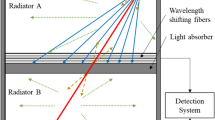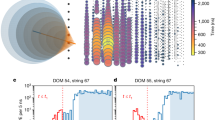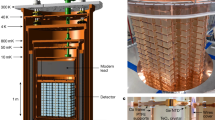Abstract
DETECTION of the small flux of extraterrestrial neutrinos expected at energies above 1 TeV, and identification of their astrophysical point sources, will require neutrino telescopes with effective areas measured in square kilometres—much larger than detectors now existing1–3. Such a device can be built only by using some naturally occurring detecting medium of enormous extent: deep Antarctic ice is a strong candidate. A neutrino telescope could be constructed by drilling holes in the ice with hot water into which photomultiplier tubes could be placed to a depth of 1 km. Neutrinos would be recorded, as in underground neutrino detectors using water as the medium, by the observation of Cerenkov radiation from secondary muons. We have begun the AMANDA (Antarctic Muon and Neutrino Detector Array) project to test this idea, and here we describe a pilot experiment using photomultiplier tubes placed into Arctic ice in Greenland. Cerenkov radiation from muons was detected, and a comparison of count rate with the expected muon flux indicates that the ice is very transparent, with an absorption length greater than 18 m. Our results suggest that a full-scale Antarctic ice detector is technically quite feasible.
This is a preview of subscription content, access via your institution
Access options
Subscribe to this journal
Receive 51 print issues and online access
$199.00 per year
only $3.90 per issue
Buy this article
- Purchase on Springer Link
- Instant access to full article PDF
Prices may be subject to local taxes which are calculated during checkout
Similar content being viewed by others
References
The DUMAND Collaboration Rep. No. HDC-3-88 (Hawaii DUMAND Center, 1988).
Barwick, S. W. et al. in Proc. 3rd Int. Workshop on Neutrino Telescopes, Venice, 1991 (in the press).
Halzen, F., Learned, J. & Stanev, T. AIP Conf. Proc. 198 (eds Mullan, D. J. et al) 39–51 (American Institute of Physics, New York, 1988).
Miyake, S. Proc. 13th international Cosmic Ray Conference Vol. 5, 3638–3655 (University of Denver, Colorado, 1973).
Davis, G. E. J. opt. Soc. Am. 45, 572–581 (1955).
Park, H. S. thesis, Univ. Michigan (1985).
Warren, S. G. Appl. Optics. 23, 1206–1225 (1984).
Trodahl, H. J., Buckley, R. G. & Brown, S. Appl. Optics 26, 3005–3017 (1987).
Gow, A. J. & Williamson, T. Cold Regions Research and Engineering Laboratory Research Rep. 339 (1975).
Smith, N. J. T. et al. Nucl. Instrum. Meth. Phys. Res. A276, 622–627 (1989).
Sullivan, J. D. Nucl. Instrum. Meth. 95, 5–11 (1971).
Author information
Authors and Affiliations
Rights and permissions
About this article
Cite this article
Lowder, D., Miller, T., Price, P. et al. Observation of muons using the polar ice cap as a Cerenkov detector. Nature 353, 331–333 (1991). https://doi.org/10.1038/353331a0
Received:
Accepted:
Issue Date:
DOI: https://doi.org/10.1038/353331a0
This article is cited by
-
Observation of high-energy neutrinos using Čerenkov detectors embedded deep in Antarctic ice
Nature (2001)
-
Putting a project on ice
Nature (1991)
Comments
By submitting a comment you agree to abide by our Terms and Community Guidelines. If you find something abusive or that does not comply with our terms or guidelines please flag it as inappropriate.



